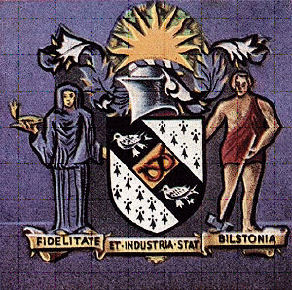 |
A History of BilstonPart 1 Pre Industrial Bilston |
|
Origins
The story of Bilston begins in the dim and distant past when Beacon Hill was crowned by a forest of oak trees where skin-clad people tended to flocks of swine. Like all primitive people they worshipped a power outside themselves under the name of Bel.
Dr Oliver tells us that Bilston is derived from "Beli", the principle male divinity in Britain in ancient times, who was the sun worshipped by the druids. Assuming that to be the case, the termination "tona" or "ton" becomes easy of explanation - it being in fact nothing more than the Saxon word "tynan", a dwelling place. Bilston therefore becomes a place name full of strange significance, for it literally means the "village of sun worship".
Bilston in Roman Times
In the year 43A.D. the Romans invaded Britain and silver coins of the reign of Antoninus (138-161) and Commodus (180-192) have been found in Bilston. This is not surprising since a Roman military road passed through the village and the large Roman station Etocetum was situated at Wall between Walsall and Lichfield on the junction of Watling Street and Icknield Street. Composed probably of rude mud huts, and inhabited by the fierce and warlike Cornovii, the village would, in the fierce forays between them and the Roman soldiers, fall into decay, while they hid themselves in the surrounding woods. Conquered at last they returned to their huts, and under their conquerors learned their first lessons of civilised life. On their return to the continent the Romans were succeeded by the Anglo-Saxons, who gave the neighbouring towns their names.
Bilston in Saxon Times
At the time that the town emerges from pre-historic darkness it was a very tiny village, consisting of a few swineherd, mud huts surrounding the stockaded residence of the Saxon landowner. The inhabitants led a more pastoral life, living chiefly on the produce of the chase and the flesh of the swine that fed in the woodland glades. The village was situated in a thick wood which extended up to the summit of the Sedgley Beacon, and lay on the edge of Cannock Forest, the boundary of which lay a little to the east, running from Wednesfield to Wednesbury, both of which were within the area of Cannock Forest. The wooded nature of the area is shown in the letter of Archbishop Sigeric respecting the endowment of Wolverhampton Church to Wulfruna, which refers to "quintus quercus" and to the vast woods bearing great quantities of acorns etc..
The charter of Lady Wulfruna to the monastery of Wolverhampton gives a very interesting account of this district at that remote period. This is Dr. Oliver's rendering of it:
"commencing at "Hind Brook " or " Stag River ", the boundary line continued straight along the ditch between Ettingshalem - where stood a large Saxon manor house - and Belstona, until it turned off at an angle eastwards towards a thorn bush, where was placed a landmark to shew the junction of Belstona, Ettingshalem and Wulfrunehamton. It then proceeded to a remarkable overflowing pool and onward to a ford where Beorgitha's paved road crossed the stream; thence along the ditch which separates Wulfrunehamton from Wodnesfelde, to Goldthorn - Holythorn, sanctum spinetum - thence to the ditch on the road to Penn to the boundary where Wulfrunehamton, Bishbyrie, and Wodnesfelde meet in an angle. From this point the line proceeded along the Burgesses River to a grove of alders; hence through Wodnesfelde, to the old village (of Belstona) by the miry road where the herds of swine are nightly folded in buildings erected for that purpose; hence to the fosse of Kunesford by the military road, to the bridge of white stones, and onwards to the Virgin's Ferry; thence down the river until it arrived at the point where the survey commenced".
The "Stag River" passed through Bilston, and thence eastward through Willenhall, where it joined the Tame, then called Beorgitha's stream.
The Saxon Hall was in all probability erected by Kerdic Wolfeard, a favourite of King Ethelwolf. During his lifetime the Danes became troublesome and he caused a strong stockade and ditch to be made round his hall and across this threw a rude moveable drawbridge, diverting one of the water courses that flowed through the scene into his ditch so as to provide it with a supply of water.
In the time of his son Kenwolf, the Danes invaded the district, and a decisive battle was fought at Stowheath, in 909 . The Saxons were defeated and the estate of Swinestam soon fell into the hands of a family named "Ett". To this was added the usual tribal patronymic "ing" meaning a family, and "hall", a residence, and these put together gave the name Ettingshall. This family was in all probability dispossessed by William the Conqueror and, as no later evidence exists, it was probably then destroyed and its owners made serfs.
click here to go on to Medieval Bilston